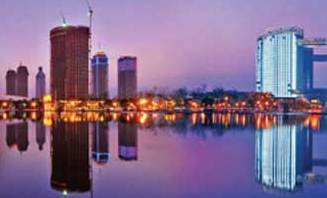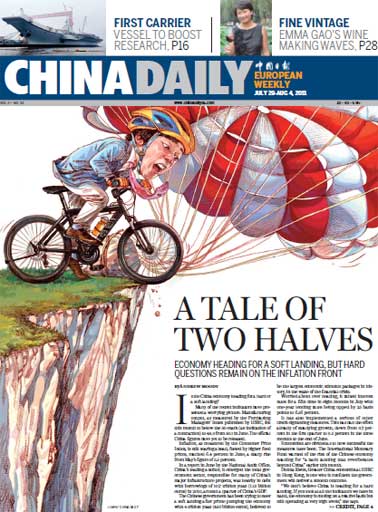Society
Word Search
Updated: 2011-08-04 08:25
By Li Xing (China Daily)
|
A road sign in today's Shanghai (left) and a sign in 2004's Nanjing showcase the improvement of translation work in the country. |

|
Marion Boers (left), president of International Federation of Translators (FIT), presents special commendation to Huang Youyi, vice-chairman of Translators Association of China (TAC), on Monday at the opening of the FIT world congress. Huang was commended for his effort to bridge cultures between China and the rest of the world through his nine-year mandate as FIT's council member and then vice-president. Li Xing / China Daily |

Translation services are the nation's latest money spinners but cut-throat competition is leading to indifferent quality. Li Xing reports from San Francisco.
Jiri Stejskal cannot forget a "Please Do Not Disturb��"sign that hung on the door of his hotel room in Beijing, seven years ago. The other side of the sign read, "Please Disturb". Narrating this to China Daily, Stejskal, vice-president of the International Federation of Translators (FIT) and chief organizer of the XIX FIT World Congress in San Francisco, says it was his first visit to China, and he remembers taking quite a few photos of this kind of "funny English"on the streets of Beijing and other cities. Since then, he has traveled to China several times and has noticed "funny English" is decreasing. "The changes are really enormous," he says, adding that translation work in China now has a much better standing in the world.
That may explain why Chinese translators have the third-largest presence - next only to the Americans and Norwegians - at the ongoing FIT world congress. The four-day forum, which opened on Monday, attracts more than 700 translators and interpreters from around the world; the registered Chinese attendees from China number 54.
They represent a booming language service industry that has grown with China's opening, rapid economic development and increased globalization that have made China the second-largest economy in the world.
The industry comprises translation/interpreting and localization services, language technology development, language teaching and consultancy in linguistic issues.
Localization services are the ones that help international firms turn their intranets, websites and even some software into Chinese as they open offices and start operations in China.
According to a study by Translators Association of China (TAC) in 2010, 15,039 firms were offering translation and/or localization services on the Chinese mainland by the end of 2009 - a dramatic rise from an estimated 3,000 businesses previously, Huang Youyi, TAC's vice-chairman, told the forum in his keynote speech on Monday. Huang has just completed a nine-year mandate as a member of FIT's council and then its vice-president.
"A very conservative estimate of the total revenue of the translation and localization outsourcing market in China is over 12 billion yuan (about $1.9 billion)," says Huang, who received a special commendation from FIT for his efforts to bridge the cultural gap between China and the rest of the world.
It accounted for 7 percent of the $26.3 billion global market for outsourced language services, a 2010 figure that comes from US-based consultant Common Sense Advisory, Huang says. Market demand is expected to increase as more Chinese companies seek to develop overseas.
Zhang Yu, a partner of Beijing MicroMice Translation, says his 6-year-old firm has just completed translating the introduction for Naked Eye 3D software into 38 languages for a company affiliated with the Chinese Academy of Sciences.
To cater to the increased demands for qualified translators and interpreters on the market, universities offering a master's program in translation and interpreting have risen from 15 in 2007 to 158 this year, Huang says. Meanwhile, some 42 universities have also opened programs offering bachelor's degrees in translation and interpreting.
The booming market has also given rise to tough competition.
"Most people in the industry see too many players as a challenge rather than an opportunity. When the market is in a very fragmented and competitive state, it will often lead to lower prices and lower quality to the detriment of the industry as a whole," Huang says.
Zhang says the rate for the 3D Naked Eye software translation was 2.25 yuan (35 US cents) a Chinese character on average, which is in the medium range.
Cut-throat prices undermine quality and professionalism, Huang says.
Stejskal likens the work of translators and interpreters to "gatekeepers", who open up the door to cross-cultural understanding.
That is why, he says, translation goes far beyond language learning, as it involves acquiring knowledge of the culture in its broadest sense.
For instance, a draft Chinese translation of a memoir by an American soldier working at an airfield in Yunnan province during World War II, described how a chef put a toothpick on top of the dough and placed it in an oven to bake a cake. Clearly the translator had no idea that the toothpick is used only to test whether a cake is done or not.
Translations of classics are very important in bridging different cultures. Over decades, almost all the top classical Chinese literature and philosophical works have been translated into multiple languages in different versions.
The best example is two English versions of the Qing Dynasty (1644-1911) novel, The Story of the Stone translated by David Hawkes, and of A Dream of Red Mansions, translated by Yang Xianyi and his wife Gladys Yang.
"The Yangs did a beautiful job and their work is well-accepted as theirs is more loyal to the original Chinese narrative," says Mao Sihui, professor and director of Center of English, Macao Polytechnic Institute, who is one of the new 17 members of the FIT Council elected on Sunday.
However, "Hawkes' The Story of the Stone is very popular because the translation is more readable," Mao says, even though some people argue the translation of a Chinese work should give a sense of its "Chinese-ness".
Mao stresses that traditions and ways of thinking in different cultures are hurdles for translators as they try to convey not only meaning but also emotions and other cultural nuances.
For example, instead of clearly articulating their ideas, ancient Chinese philosophers expressed their thoughts in ways that required their readers to have a "feel" for, or "sense", their messages, Mao says. "International readers are often clueless as to what these ancient Chinese talked about."
Meanwhile, the contemporary world with its rapid scientific and technological advances and economic globalization, also requires translators to master special knowledge and know their customers, Stejskal says.
Translation can go wrong for lack of essential knowledge. For instance, an English-to-Spanish translation of directions on a container of baby formula had such errors that if it hadn't been discovered before the product went on sale, it would have had serious consequences, Stejskal says.
He also described an earlier Japanese language introduction to the iPad, which was translated from English.
The translators assumed the iPad would be used by young people so they used Japanese words and expressions familiar only to young customers.
They were not aware that a lot of Japanese adults and even seniors also buy iPads, Stejskal says. The language used in the earlier version of the introduction to the iPad was not suited to the needs of adult users.
China's language services, too, have to face similar challenges of satisfying the demands of specialized fields, Huang says.
Zhang points out that the bulk of language services deal with straight technical, industrial and business translations that emphasize accurate renderings of meanings from one language to another.
At present, there is only one general national accreditation test for translators and interpreters.
"In the actual translation and interpreting market, specialization is often required. What's more, the language service industry also requires other types of talents, such as multilingual project managers, tool developers and terminologists," Huang says.
Huang is a major promoter of the use of Chinese instead of foreign language initials for terms from the West. Early 20th century Chinese translators were able to render modern Western inventions into simple but good Chinese, such as feiji for airplane, or tanke, for tank, he says.
However, contemporary Chinese translators are not doing a good job of translating contemporary economic, management, scientific and technological terms into simple and understandable Chinese terms, he says.
For instance, there is still no good and short Chinese phrase for MP3. What is used is a lengthy explanation that it is a patented digital audio encoding format using a form of lossy data compression.
In a taxi ride in Beijing, the cab driver told Huang that he didn't know what IPO (initial public offering) meant even though the radio anchor read out business news day after day.
"Whether you convey the meaning or the pronunciation, you must enable the man on the street to memorize the new terms," Huang says.
"That's what contemporary Chinese translators must strive for."
E-paper

Double vision
Prosperous Hangzhou banks on creative energies to bridge traditional and modern sectors
Minding matters
A touch of glass
No longer going by the book
Specials

Ancient plate broken
An ancient porcelain plate was accidentally destroyed during a research in the Palace Museum.

Selfless actions
A 20-year-old girl becomes an Internet star for giving her first kiss to a drowning old man.

Space race
Homebuyers are learning the hard facts of supply and demand: too many cars and too few parking spaces.


